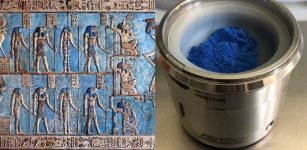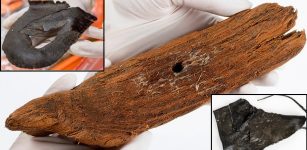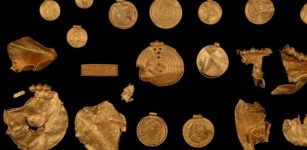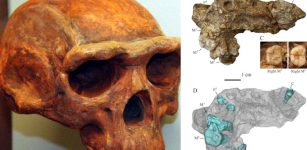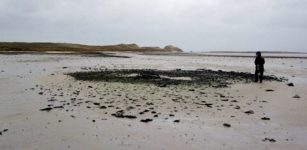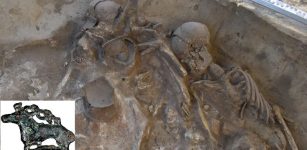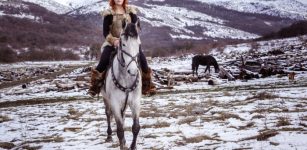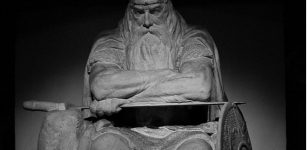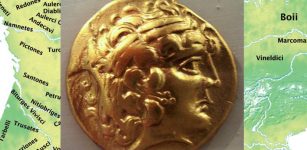Mysterious White Mass On The Heads Of The Tarim Basin Mummies Identified
Jan Bartek - AncientPages.com - In China, archaeologists have discovered several mummies naturally preserved by desert sand. However, the white mass found on their heads remained a mystery for years. Recently, researchers have uncovered an unusual explanation.
Approximately two decades ago, archaeologists unearthed mummies in the Xiaohe cemetery in Northwestern China's Tarim Basin in the Taklamakan desert. These mummies date back around 3,300 to 3,600 years ago, during the Bronze Age. The mysterious white substances were found smeared on their heads and necks. Initially, scientists speculated that these substances might be some fermented dairy product but could not identify them precisely.
A mummy from the Xiaohe cemetery and dairy remains are scattered around the neck of the mummy. Credit: Li Wenying, Xinjiang Cultural Relics and Archaeology Institute
Thanks to over a decade of advancements in ancient DNA analysis, a team led by Qiaomei Fu at the Institute of Vertebrate Paleontology and Paleoanthropology at the Chinese Academy of Sciences has finally solved this enigma.
Researchers can now reveal that the white mass is ancient cheese! According to the study, the discovery suggests a new origin for kefir cheese and sheds light on the evolution of probiotic bacteria.
"This is the oldest known cheese sample ever discovered in the world.
Food items like cheese are extremely difficult to preserve over thousands of years, making this a rare and valuable opportunity. Studying the ancient cheese in great detail can help us better understand our ancestors' diet and culture," says Qiaomei Fu.
The Bronze Age dairy remains (aged about 3500 BP) from tombs M29 of the Xiaohe cemetery. Credit: Copyright: PING Wanjing, Institute of Vertebrate Paleontology and Paleoanthropology, Chinese Academy of Sciences
The researchers successfully extracted mitochondrial DNA from samples found in three distinct tombs at the cemetery. They identified cow and goat DNA within the cheese samples. Notably, the ancient Xiaohe people utilized different types of animal milk in separate batches, a practice that contrasts with the mixing of milk types commonly observed in Middle Eastern and Greek cheesemaking traditions.
Crucially, Fu and her colleagues recovered the DNA of microorganisms from these dairy samples, thereby confirming that the white substances were indeed kefir cheese. The analysis revealed bacterial and fungal species, including Lactobacillus kefiranofaciens and Pichia kudriavzevii, both of which are prevalent in contemporary kefir grains.
Kefir grains are symbiotic cultures comprising multiple species of probiotic bacteria and yeast that ferment milk into kefir cheese, functioning similarly to a sourdough starter. The ability to sequence bacterial genes from ancient kefir cheese allowed the team to trace the evolutionary trajectory of probiotic bacteria over approximately 3,600 years. Specifically, they compared ancient Lactobacillus kefiranofaciens found in the historical kefir cheese and its modern-day counterpart.
Kefir cheese discovered on the Tarim mummies. Credit: Yimin Yang
Today, there are two primary groups of Lactobacillus bacteria: one originating from Russia and another from Tibet. The Russian type is the most widely used globally, including in the US, Japan, and European countries, for producing yogurt and cheese. Recent research has revealed that the Lactobacillus kefiranofaciens found in samples is more closely related to the Tibetan group. This discovery challenges the long-held belief that kefir originated exclusively in the North Caucasus mountain region of modern-day Russia.
The study also revealed how Lactobacillus kefiranofaciens exchanged genetic material with related strains, improving its genetic stability and milk fermentation capabilities over time.
Compared with ancient Lactobacillus, modern-day bacteria are less likely to trigger an immune response in the human intestine. This suggests that the genetic exchanges also helped Lactobacillus become more adapted to human hosts over thousands of years of interaction.
"This is an unprecedented study, allowing us to observe how a bacterium evolved over the past 3,000 years. Moreover, by examining dairy products, we've gained a clearer picture of ancient human life and their interactions with the world," says Fu.
"This is just the beginning, and with this technology, we hope to explore other previously unknown artifacts."
The study was published in the journal Cell
Written by Jan Bartek - AncientPages.com Staff Writer




